
Jakob Farnung
@jakobfarnung.bsky.social
PostDoc Schulman Lab, MPI Biochemistry; formerly Bode Lab, ETH Zürich
Pinned
Jakob Farnung
@jakobfarnung.bsky.social
· Jan 29

C-terminal amides mark proteins for degradation via SCF–FBXO31 - Nature
SCF–FBXO31 scans proteins for C-terminal amidation and marks them for subsequent proteasomal degradation.
www.nature.com
🎉Super excited to share our story on how the substrate receptor FBXO31 functions as a quality control factor by recognizing amides. This has been an amazing collaboration between Bode lab and @jcornlab.bsky.social. Special shutout goes to @matthiasmuhar.bsky.social www.nature.com/articles/s41...
Reposted by Jakob Farnung
Check out the latest work from our lab, led by Daniel Lin and Lara Elcavage: www.biorxiv.org/content/10.1... (1/3)

mRNA 3′ UTRs direct microRNA degradation to participate in imprinted gene networks and regulate growth
MicroRNAs direct downregulation of target mRNAs. Sometimes, however, this regulatory paradigm inverts, and a target RNA triggers the degradation of a microRNA. This target-directed microRNA degradatio...
www.biorxiv.org
November 7, 2025 at 6:33 PM
Check out the latest work from our lab, led by Daniel Lin and Lara Elcavage: www.biorxiv.org/content/10.1... (1/3)
Reposted by Jakob Farnung
Have a look at this Tools of the Trade Article I wrote for @natrevmcb.nature.com on decoding #ubiquitin signals inside cells using UbiREAD!
Many thanks to @lisaheinke.bsky.social for the opportunity to write this TotT!
Many thanks to @lisaheinke.bsky.social for the opportunity to write this TotT!
ICYMI: New Online! Decoding ubiquitin signals inside cells

Decoding ubiquitin signals inside cells
Nature Reviews Molecular Cell Biology, Published online: 31 October 2025; doi:10.1038/s41580-025-00919-zIn this Tools of the Trade article, Kiss (Schulman lab) discusses the development of UbiREAD, a method that delivers in vitro-ubiquitinated protein reporters into cells to systematically assess how different ubiquitin chain configurations affect protein stability and degradation.
bit.ly
November 4, 2025 at 10:04 AM
Have a look at this Tools of the Trade Article I wrote for @natrevmcb.nature.com on decoding #ubiquitin signals inside cells using UbiREAD!
Many thanks to @lisaheinke.bsky.social for the opportunity to write this TotT!
Many thanks to @lisaheinke.bsky.social for the opportunity to write this TotT!
Reposted by Jakob Farnung
ICYMI: New Online! Decoding ubiquitin signals inside cells

Decoding ubiquitin signals inside cells
Nature Reviews Molecular Cell Biology, Published online: 31 October 2025; doi:10.1038/s41580-025-00919-zIn this Tools of the Trade article, Kiss (Schulman lab) discusses the development of UbiREAD, a method that delivers in vitro-ubiquitinated protein reporters into cells to systematically assess how different ubiquitin chain configurations affect protein stability and degradation.
bit.ly
November 3, 2025 at 5:06 PM
ICYMI: New Online! Decoding ubiquitin signals inside cells
Reposted by Jakob Farnung
🧬 Transcription elongation by RNA polymerase II relies on a web of elongation factors. Our new work shows how IWS1 acts as a modular scaffold to stabilize & stimulate elongation. Fantastic work by Della Syau! www.biorxiv.org/content/10.1...
August 29, 2025 at 10:14 AM
🧬 Transcription elongation by RNA polymerase II relies on a web of elongation factors. Our new work shows how IWS1 acts as a modular scaffold to stabilize & stimulate elongation. Fantastic work by Della Syau! www.biorxiv.org/content/10.1...
Reposted by Jakob Farnung
Excited to share our latest study in @natcomms.nature.com , where we characterize the chaperone function of the ER membrane protein complex (EMC)—supporting membrane protein biogenesis beyond insertion!
1/9
www.nature.com/articles/s41...
1/9
www.nature.com/articles/s41...
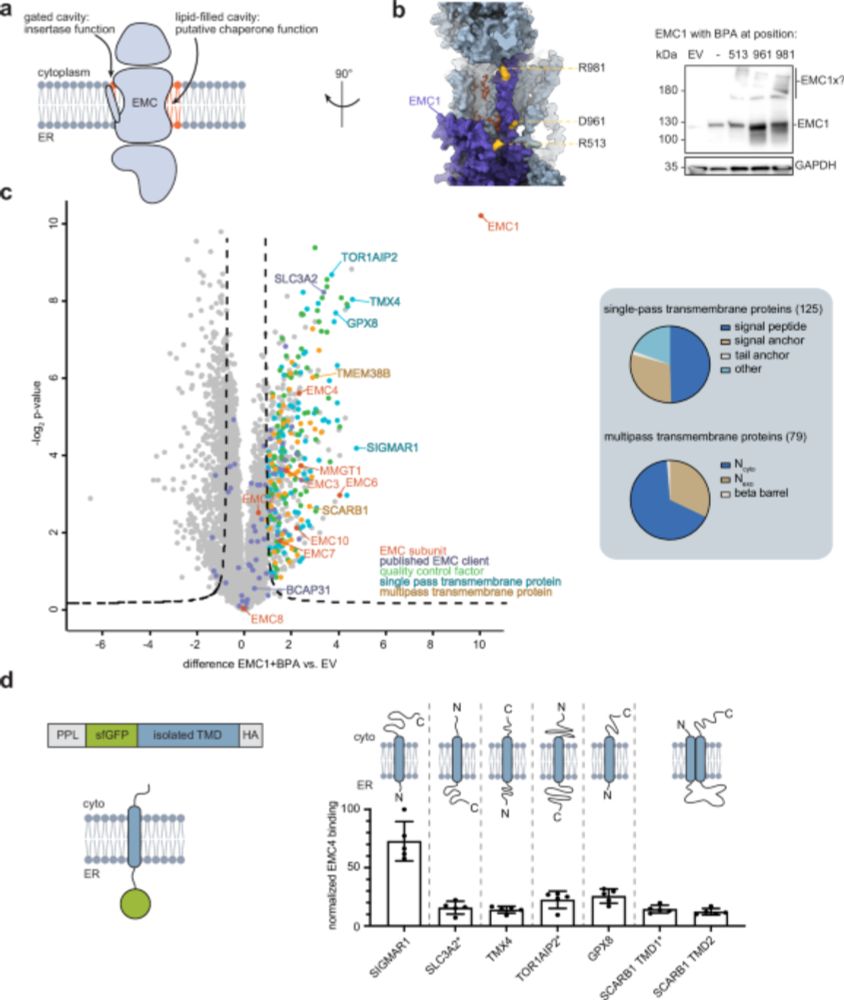
The EMC acts as a chaperone for membrane proteins - Nature Communications
Membrane proteins are essential for any cell but difficult to fold. Here, the authors show that the EMC acts as a chaperone for membrane proteins. They dissect client recognition and provide a molecul...
www.nature.com
August 5, 2025 at 1:18 PM
Excited to share our latest study in @natcomms.nature.com , where we characterize the chaperone function of the ER membrane protein complex (EMC)—supporting membrane protein biogenesis beyond insertion!
1/9
www.nature.com/articles/s41...
1/9
www.nature.com/articles/s41...
Reposted by Jakob Farnung
Excited about #ubiquitin and #TPD ?
Then join us tomorrow for the latest instalment of the @danafarber.bsky.social Targeted Protein Degradation Webinar where Kimberly Stegmaier and I will present our latest work.
dfci.zoom.us/webinar/regi...
Then join us tomorrow for the latest instalment of the @danafarber.bsky.social Targeted Protein Degradation Webinar where Kimberly Stegmaier and I will present our latest work.
dfci.zoom.us/webinar/regi...

June 25, 2025 at 9:08 PM
Excited about #ubiquitin and #TPD ?
Then join us tomorrow for the latest instalment of the @danafarber.bsky.social Targeted Protein Degradation Webinar where Kimberly Stegmaier and I will present our latest work.
dfci.zoom.us/webinar/regi...
Then join us tomorrow for the latest instalment of the @danafarber.bsky.social Targeted Protein Degradation Webinar where Kimberly Stegmaier and I will present our latest work.
dfci.zoom.us/webinar/regi...
Reposted by Jakob Farnung
Congratulations to our own Lucas Farnung @lucas.farnunglab.com who has been named as one of 30 Freeman Hrabowski Scholars for 2025 by the Howard Hughes Medical Institute (HHMI). So well deserved deserved !! www.hhmi.org/programs/fre...

The 2025 Freeman Hrabowski Scholars | HHMI
Freeman Hrabowski Scholars are outstanding early career faculty who have the potential to become leaders in their research fields.
www.hhmi.org
June 18, 2025 at 3:26 PM
Congratulations to our own Lucas Farnung @lucas.farnunglab.com who has been named as one of 30 Freeman Hrabowski Scholars for 2025 by the Howard Hughes Medical Institute (HHMI). So well deserved deserved !! www.hhmi.org/programs/fre...
Reposted by Jakob Farnung
Schulman lab is ready for the GRK2243 Symposium: Understanding ubiquitination: from molecular mechanisms to disease in würzburg
#wUeBI2025 @grk2243.bsky.social
@jakobfarnung.bsky.social @samuelmaiwald.bsky.social @hannahbkmpr.bsky.social
#wUeBI2025 @grk2243.bsky.social
@jakobfarnung.bsky.social @samuelmaiwald.bsky.social @hannahbkmpr.bsky.social
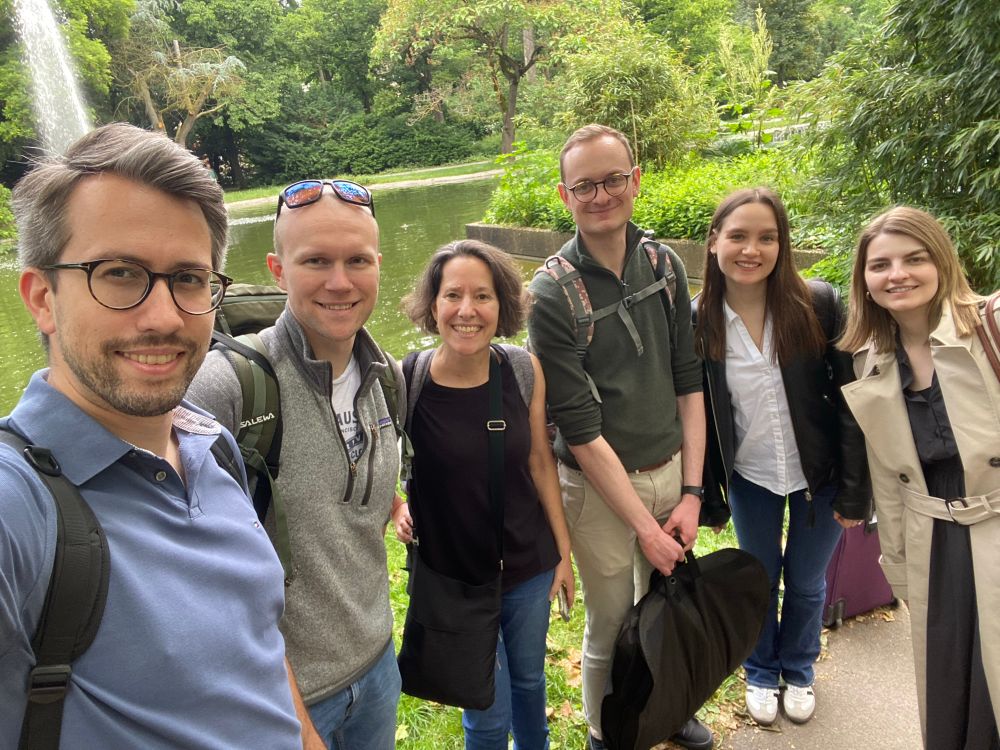
June 2, 2025 at 10:16 AM
Schulman lab is ready for the GRK2243 Symposium: Understanding ubiquitination: from molecular mechanisms to disease in würzburg
#wUeBI2025 @grk2243.bsky.social
@jakobfarnung.bsky.social @samuelmaiwald.bsky.social @hannahbkmpr.bsky.social
#wUeBI2025 @grk2243.bsky.social
@jakobfarnung.bsky.social @samuelmaiwald.bsky.social @hannahbkmpr.bsky.social
Super cool story on branched UB chain formation. Congrats Sam!
Excited to share our latest study on how K29/K48-branched #ubiquitin chains are forged by the #E3 ligase TRIP12, and how this suggests a consensus mechanism for chain formation by HECT E3s!
@natsmb.nature.com
1/7
www.nature.com/articles/s41...
@natsmb.nature.com
1/7
www.nature.com/articles/s41...

TRIP12 structures reveal HECT E3 formation of K29 linkages and branched ubiquitin chains - Nature Structural & Molecular Biology
Using biochemistry, chemical biology, and cryo-EM, Maiwald et al. elucidate how TRIP12 forms K29 linkages and K29/K48-linked branched ubiquitin chains, revealing a mechanism for polyubiquitylation sha...
www.nature.com
May 26, 2025 at 9:48 AM
Super cool story on branched UB chain formation. Congrats Sam!
Reposted by Jakob Farnung
Excited to share our latest study on how K29/K48-branched #ubiquitin chains are forged by the #E3 ligase TRIP12, and how this suggests a consensus mechanism for chain formation by HECT E3s!
@natsmb.nature.com
1/7
www.nature.com/articles/s41...
@natsmb.nature.com
1/7
www.nature.com/articles/s41...

TRIP12 structures reveal HECT E3 formation of K29 linkages and branched ubiquitin chains - Nature Structural & Molecular Biology
Using biochemistry, chemical biology, and cryo-EM, Maiwald et al. elucidate how TRIP12 forms K29 linkages and K29/K48-linked branched ubiquitin chains, revealing a mechanism for polyubiquitylation sha...
www.nature.com
May 26, 2025 at 9:37 AM
Excited to share our latest study on how K29/K48-branched #ubiquitin chains are forged by the #E3 ligase TRIP12, and how this suggests a consensus mechanism for chain formation by HECT E3s!
@natsmb.nature.com
1/7
www.nature.com/articles/s41...
@natsmb.nature.com
1/7
www.nature.com/articles/s41...
Reposted by Jakob Farnung

🧬🎉Thrilled to share our new chromatin remodeling study! We reveal three states of human CHD1 and identify a novel "anchor element" that interacts with the acidic patch—conserved among remodelers. Our structures clarify mechanisms of remodeler recruitment! Link: authors.elsevier.com/a/1l2ik3vVUP...
🧬🎉Thrilled to share our new chromatin remodeling study! We reveal three states of human CHD1 and identify a novel "anchor element" that interacts with the acidic patch—conserved among remodelers. Our structures clarify mechanisms of remodeler recruitment! Link: authors.elsevier.com/a/1l2ik3vVUP...
May 6, 2025 at 3:08 PM

🧬🎉Thrilled to share our new chromatin remodeling study! We reveal three states of human CHD1 and identify a novel "anchor element" that interacts with the acidic patch—conserved among remodelers. Our structures clarify mechanisms of remodeler recruitment! Link: authors.elsevier.com/a/1l2ik3vVUP...
🧬🎉Thrilled to share our new chromatin remodeling study! We reveal three states of human CHD1 and identify a novel "anchor element" that interacts with the acidic patch—conserved among remodelers. Our structures clarify mechanisms of remodeler recruitment! Link: authors.elsevier.com/a/1l2ik3vVUP...
Reposted by Jakob Farnung
New Preprint: We have solved the structure of the proteasome in complex with two different ubiquitin chains: www.biorxiv.org/content/10.1... This work is spearheaded by PhD Student Sascha Amann
Let me walk you through it 🧵 1/9
Let me walk you through it 🧵 1/9

Structural basis for the ubiquitin chain recognition of the human 26S proteasome
Proteasomal degradation is a fundamental process for all eukaryotic life. A protein destined for degradation is first tagged with a polyubiquitin chain, which is selected by the proteasome. Different ...
www.biorxiv.org
April 9, 2025 at 8:59 AM
New Preprint: We have solved the structure of the proteasome in complex with two different ubiquitin chains: www.biorxiv.org/content/10.1... This work is spearheaded by PhD Student Sascha Amann
Let me walk you through it 🧵 1/9
Let me walk you through it 🧵 1/9
If you are interested in Ubiquitin this paper is a must read! Congrats Leo!
Super excited to share our latest work on deciphering the #Ubiquitin Code
“𝗨𝗯𝗶𝗥𝗘𝗔𝗗 𝗱𝗲𝗰𝗶𝗽𝗵𝗲𝗿𝘀 𝗽𝗿𝗼𝘁𝗲𝗮𝘀𝗼𝗺𝗮𝗹 𝗱𝗲𝗴𝗿𝗮𝗱𝗮𝘁𝗶𝗼𝗻 𝗰𝗼𝗱𝗲 𝗼𝗳 𝗵𝗼𝗺𝗼𝘁𝘆𝗽𝗶𝗰 𝗮𝗻𝗱 𝗯𝗿𝗮𝗻𝗰𝗵𝗲𝗱 𝗞48 𝗮𝗻𝗱 𝗞63 𝘂𝗯𝗶𝗾𝘂𝗶𝘁𝗶𝗻 𝗰𝗵𝗮𝗶𝗻𝘀”
@cp-molcell.bsky.social
1/8
www.cell.com/molecular-ce...
“𝗨𝗯𝗶𝗥𝗘𝗔𝗗 𝗱𝗲𝗰𝗶𝗽𝗵𝗲𝗿𝘀 𝗽𝗿𝗼𝘁𝗲𝗮𝘀𝗼𝗺𝗮𝗹 𝗱𝗲𝗴𝗿𝗮𝗱𝗮𝘁𝗶𝗼𝗻 𝗰𝗼𝗱𝗲 𝗼𝗳 𝗵𝗼𝗺𝗼𝘁𝘆𝗽𝗶𝗰 𝗮𝗻𝗱 𝗯𝗿𝗮𝗻𝗰𝗵𝗲𝗱 𝗞48 𝗮𝗻𝗱 𝗞63 𝘂𝗯𝗶𝗾𝘂𝗶𝘁𝗶𝗻 𝗰𝗵𝗮𝗶𝗻𝘀”
@cp-molcell.bsky.social
1/8
www.cell.com/molecular-ce...
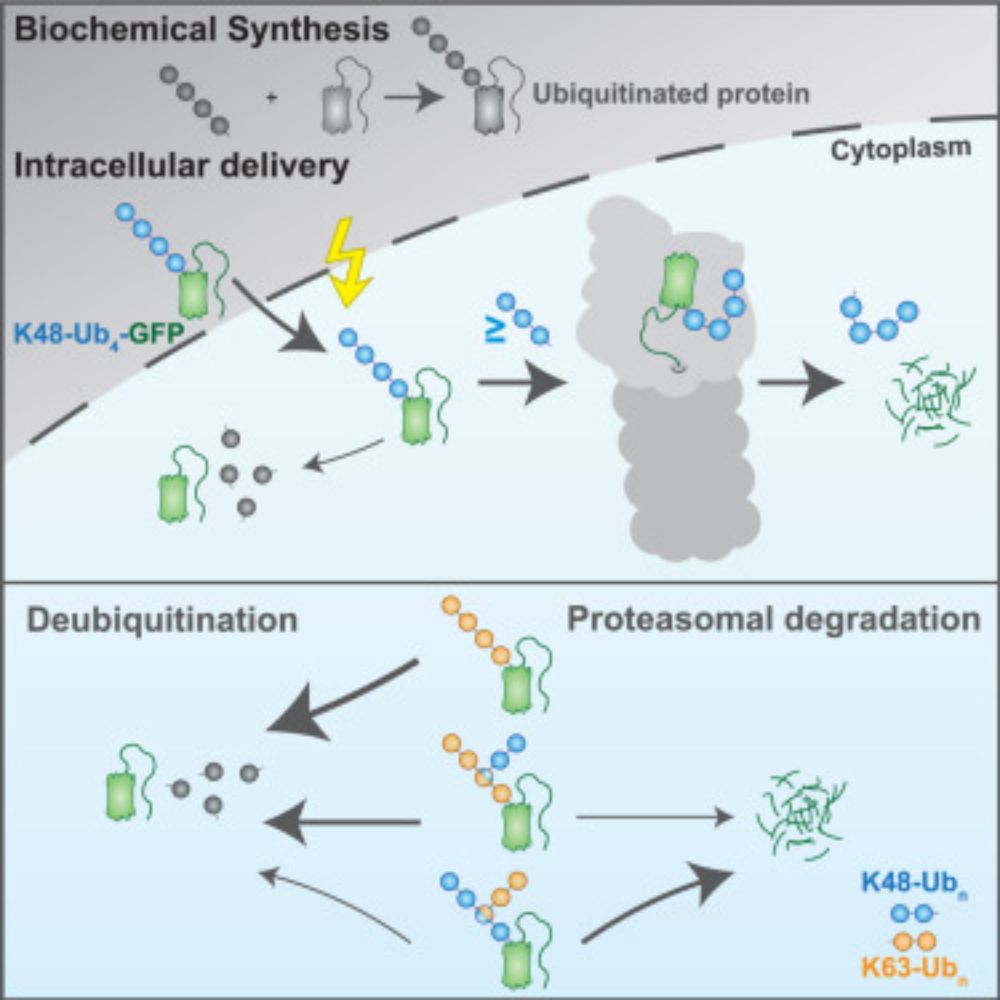
UbiREAD deciphers proteasomal degradation code of homotypic and branched K48 and K63 ubiquitin chains
Ubiquitin chains determine the fates of their modified proteins, including proteasomal
degradation. Kiss et al. present UbiREAD, a technology to monitor cellular degradation
and deubiquitination at hi...
www.cell.com
March 24, 2025 at 3:08 PM
If you are interested in Ubiquitin this paper is a must read! Congrats Leo!
Reposted by Jakob Farnung
It's finally out – actually out and in print! Many thanks to @jcornlab.bsky.social @matthiasmuhar.bsky.social @jakobfarnung.bsky.social and all the fantastic collaborators. What started as pure curiosity lead to an amazing find!
www.nature.com/articles/s41...
www.nature.com/articles/s41...
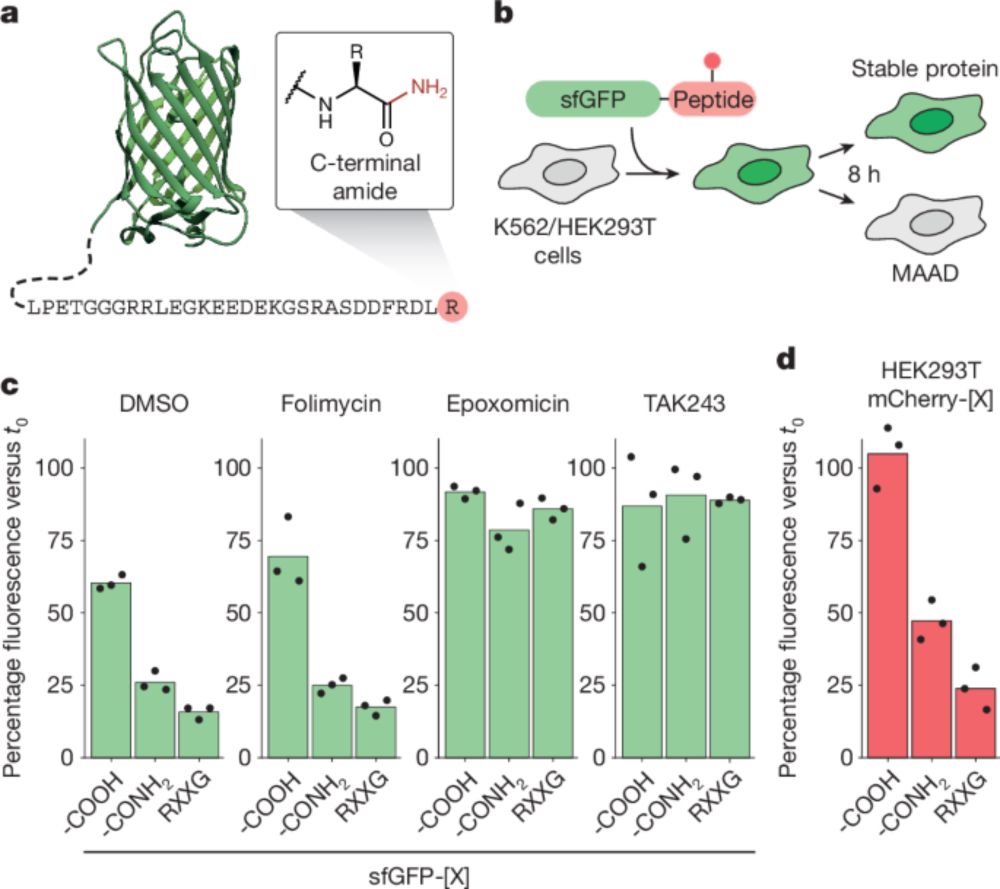
C-terminal amides mark proteins for degradation via SCF–FBXO31 - Nature
SCF–FBXO31 scans proteins for C-terminal amidation and marks them for subsequent proteasomal degradation.
www.nature.com
February 12, 2025 at 8:23 PM
It's finally out – actually out and in print! Many thanks to @jcornlab.bsky.social @matthiasmuhar.bsky.social @jakobfarnung.bsky.social and all the fantastic collaborators. What started as pure curiosity lead to an amazing find!
www.nature.com/articles/s41...
www.nature.com/articles/s41...
Reposted by Jakob Farnung
Today in @nature.com we share our back-to-back stories with Ning Zheng’s lab revealing chemical-genetic convergence between a molecular glue degrader & E3 ligase cancer mutations. 1/5
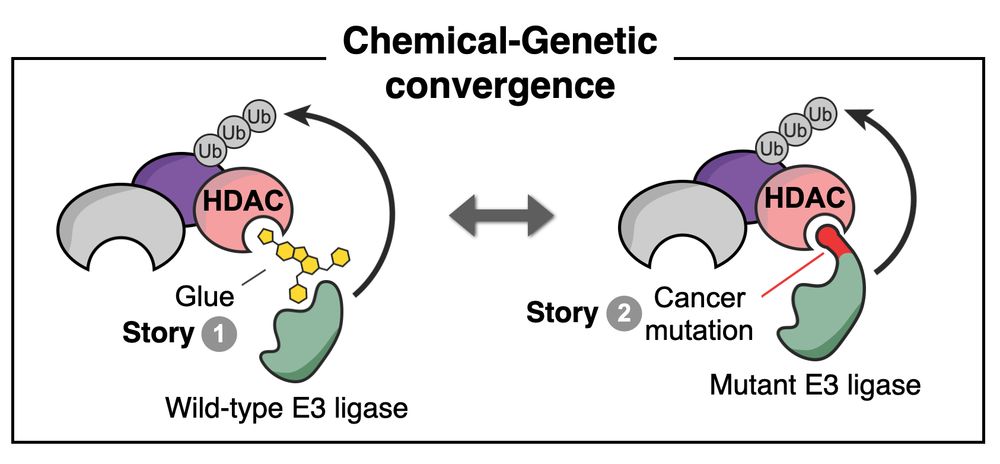
February 12, 2025 at 4:20 PM
Today in @nature.com we share our back-to-back stories with Ning Zheng’s lab revealing chemical-genetic convergence between a molecular glue degrader & E3 ligase cancer mutations. 1/5
Reposted by Jakob Farnung
Excited about mechanistic biology and processes in the cell's nucleus? Join our lab as a post-doctoral researcher! We have a state-of-the-art cryo-EM facility (new microscopes coming!), a brand-new lab space, and a vibrant community at HMS!
DM/email me or check farnunglab.com for more info.
DM/email me or check farnunglab.com for more info.

Farnung Lab
farnunglab.com
January 31, 2025 at 4:16 PM
Excited about mechanistic biology and processes in the cell's nucleus? Join our lab as a post-doctoral researcher! We have a state-of-the-art cryo-EM facility (new microscopes coming!), a brand-new lab space, and a vibrant community at HMS!
DM/email me or check farnunglab.com for more info.
DM/email me or check farnunglab.com for more info.
Reposted by Jakob Farnung
Our story on the mechanism of co-transcriptional histone mark deposition is now officially out: www.science.org/doi/10.1126/...

Structural basis of H3K36 trimethylation by SETD2 during chromatin transcription
During transcription, RNA polymerase II traverses through chromatin, and posttranslational modifications including histone methylations mark regions of active transcription. Histone protein H3 lysine ...
www.science.org
January 30, 2025 at 10:16 PM
Our story on the mechanism of co-transcriptional histone mark deposition is now officially out: www.science.org/doi/10.1126/...
Reposted by Jakob Farnung
Cells are filled with toxic stuff that damages healthy proteins. Is that garbage just left to rot on the curb? No way! Ubiquitin ligases have evolved to recognize chemical damage and clean it up! www.nature.com/articles/s41...

C-terminal amides mark proteins for degradation via SCF–FBXO31 - Nature
SCF–FBXO31 scans proteins for C-terminal amidation and marks them for subsequent proteasomal degradation.
www.nature.com
January 30, 2025 at 12:30 PM
Cells are filled with toxic stuff that damages healthy proteins. Is that garbage just left to rot on the curb? No way! Ubiquitin ligases have evolved to recognize chemical damage and clean it up! www.nature.com/articles/s41...
Reposted by Jakob Farnung
scary but fascinating - cells have a degradation pathway that hunts down C-terminal scars (amides!) on damaged proteins. just wow. chemical biology plus CRISPR at its best. big congrats to all authors!
www.nature.com/articles/s41...
www.nature.com/articles/s41...

C-terminal amides mark proteins for degradation via SCF–FBXO31 - Nature
SCF–FBXO31 scans proteins for C-terminal amidation and marks them for subsequent proteasomal degradation.
www.nature.com
January 29, 2025 at 5:57 PM
scary but fascinating - cells have a degradation pathway that hunts down C-terminal scars (amides!) on damaged proteins. just wow. chemical biology plus CRISPR at its best. big congrats to all authors!
www.nature.com/articles/s41...
www.nature.com/articles/s41...
Reposted by Jakob Farnung
Very excited to highlight @jcornlab's beautiful work on the E3 ligase SCF-FBXO31, which recognizes chemically damaged proteins. Mutations in FBXO31 cause disease by substrate-rewiring, really cool. Congratulations to all authors!
rdcu.be/d7WGc
rdcu.be/d7WGc
Signs of damage that drive protein degradation | Nature
Many environmental toxins damage proteins, which then must be removed to avoid dangerous protein aggregation and disease. How cells dispose of chemically modified proteins has been unclear, but a discovery offers some clues. How the stress-response machinery eliminates damaged proteins.
rdcu.be
January 29, 2025 at 4:48 PM
Very excited to highlight @jcornlab's beautiful work on the E3 ligase SCF-FBXO31, which recognizes chemically damaged proteins. Mutations in FBXO31 cause disease by substrate-rewiring, really cool. Congratulations to all authors!
rdcu.be/d7WGc
rdcu.be/d7WGc
Reposted by Jakob Farnung
Super exiting new work revealing a novel quality control pathway for c-terminal amides!
🎉Super excited to share our story on how the substrate receptor FBXO31 functions as a quality control factor by recognizing amides. This has been an amazing collaboration between Bode lab and @jcornlab.bsky.social. Special shutout goes to @matthiasmuhar.bsky.social www.nature.com/articles/s41...

C-terminal amides mark proteins for degradation via SCF–FBXO31 - Nature
SCF–FBXO31 scans proteins for C-terminal amidation and marks them for subsequent proteasomal degradation.
www.nature.com
January 29, 2025 at 5:12 PM
Super exiting new work revealing a novel quality control pathway for c-terminal amides!
Reposted by Jakob Farnung
On the degradation of damaged cellular proteins via C-terminal amidation. By Alfred Freeberg & @micharapelab.bsky.social. @ispt-proteinterm.bsky.social www.nature.com/articles/d41...

Signs of damage that drive protein degradation
How the stress-response machinery eliminates damaged proteins.
www.nature.com
January 29, 2025 at 5:34 PM
On the degradation of damaged cellular proteins via C-terminal amidation. By Alfred Freeberg & @micharapelab.bsky.social. @ispt-proteinterm.bsky.social www.nature.com/articles/d41...
🎉Super excited to share our story on how the substrate receptor FBXO31 functions as a quality control factor by recognizing amides. This has been an amazing collaboration between Bode lab and @jcornlab.bsky.social. Special shutout goes to @matthiasmuhar.bsky.social www.nature.com/articles/s41...

C-terminal amides mark proteins for degradation via SCF–FBXO31 - Nature
SCF–FBXO31 scans proteins for C-terminal amidation and marks them for subsequent proteasomal degradation.
www.nature.com
January 29, 2025 at 4:29 PM
🎉Super excited to share our story on how the substrate receptor FBXO31 functions as a quality control factor by recognizing amides. This has been an amazing collaboration between Bode lab and @jcornlab.bsky.social. Special shutout goes to @matthiasmuhar.bsky.social www.nature.com/articles/s41...
Reposted by Jakob Farnung
Our paper describing a novel DNA binding mode for MORC2 is published! Congratulations to Nika Fendler on her first, first author paper. This was an epic effort and revealed many new and unpredicted functions for MORC2. You can read about it here: tinyurl.com/MORC2-DNA
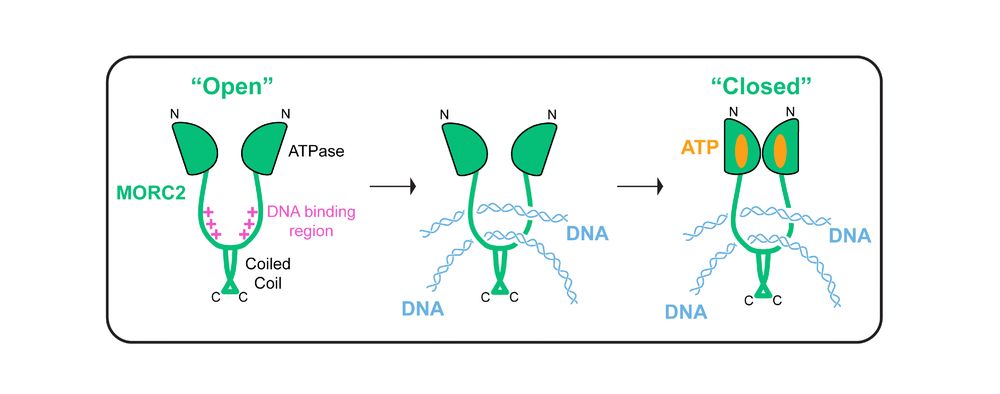
December 31, 2024 at 3:23 PM
Our paper describing a novel DNA binding mode for MORC2 is published! Congratulations to Nika Fendler on her first, first author paper. This was an epic effort and revealed many new and unpredicted functions for MORC2. You can read about it here: tinyurl.com/MORC2-DNA
Reposted by Jakob Farnung
🎄 xmas preprint 🎄 we are excited to share our cryo-EM structure of UBR4 in complex with KCMF1 and CALM1. the PQC ligase forms a massive ubiquitination arena, primed to amplify ubiquitin chains (E4 activity) and boost degradation of defective proteins. www.biorxiv.org/content/10.1...

December 21, 2024 at 10:46 AM
🎄 xmas preprint 🎄 we are excited to share our cryo-EM structure of UBR4 in complex with KCMF1 and CALM1. the PQC ligase forms a massive ubiquitination arena, primed to amplify ubiquitin chains (E4 activity) and boost degradation of defective proteins. www.biorxiv.org/content/10.1...

